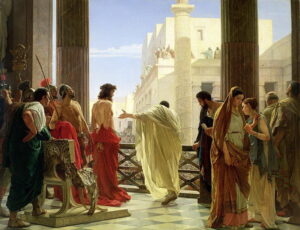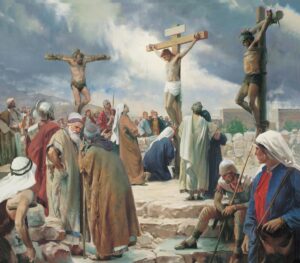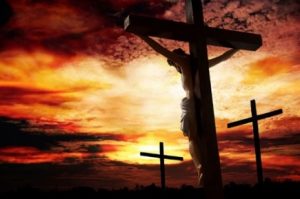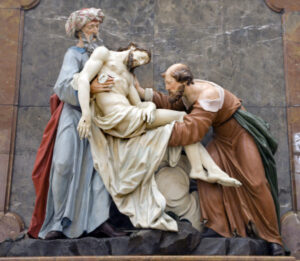John 19 – The Crucifixion of Jesus
 He was despised and forsaken of men, A man of sorrows and acquainted with grief; And like one from whom men hide their f
He was despised and forsaken of men, A man of sorrows and acquainted with grief; And like one from whom men hide their f![]() ace He was despised, and we did not esteem Him. Surely our griefs He Himself bore, And our sorrows He carried; Yet we ourselves esteemed Him stricken, Smitten of God, and afflicted. But He was pierced through for our transgressions, He was crushed for our iniquities; The chastening for our well-being fell upon Him, And by His scourging we are healed. All of us like sheep have gone astray, Each of us has turned to his own way; But the LORD has caused the iniquity of us all To fall on Him. He was oppressed and He was afflicted, Yet He did not open His mouth; Like a lamb that is led to slaughter, And like a sheep that is silent before its shearers, So He did not open His mouth. –Isaiah 53:3-
ace He was despised, and we did not esteem Him. Surely our griefs He Himself bore, And our sorrows He carried; Yet we ourselves esteemed Him stricken, Smitten of God, and afflicted. But He was pierced through for our transgressions, He was crushed for our iniquities; The chastening for our well-being fell upon Him, And by His scourging we are healed. All of us like sheep have gone astray, Each of us has turned to his own way; But the LORD has caused the iniquity of us all To fall on Him. He was oppressed and He was afflicted, Yet He did not open His mouth; Like a lamb that is led to slaughter, And like a sheep that is silent before its shearers, So He did not open His mouth. –Isaiah 53:3-

Behold the Man! John 19:5
At his first meeting with Jesus (18:33-38), Pilate was confronted by genuine Truth and found no guilt in Him. The Jews still vehemently demanded crucifixion, so he now makes what was likely a surprising, profound gesture by having a ![]() second audience with the Accused. He goes back into his private quarters and “talks” with Jesus again, this time with a discussion about who holds ultimate authority. He uses ominous words, “Don’t You know I have the power to crucify You?” Regrettable that he doesn’t recognize the reality of Who holds that power.
second audience with the Accused. He goes back into his private quarters and “talks” with Jesus again, this time with a discussion about who holds ultimate authority. He uses ominous words, “Don’t You know I have the power to crucify You?” Regrettable that he doesn’t recognize the reality of Who holds that power.
When he comes back out to speak again to the crowd, he sits in “the Judgment Seat”, an emblem of summary judgment supposedly possessed by the Roman government. Jesus at this point is likely a pitiable and horrible sight bearing the results of the thorns on his head, and torturous beating He endured. The Gospel accounts are not notably graphic about the torture Jesus endured – the scourging alone would have left Jesus’ back shredded deeply. Pilate speaks the same conclus ion, no guilt, he wanted to release Jesus – yet the Jews have him in a bind – they threaten him with Caesar’s wrath (19:12). So he has to satisfy their fury, he surrenders Jesus to His destiny in their hands.
ion, no guilt, he wanted to release Jesus – yet the Jews have him in a bind – they threaten him with Caesar’s wrath (19:12). So he has to satisfy their fury, he surrenders Jesus to His destiny in their hands.
Interesting to see the term “judgment seat” used here with Pilate. This Greek term, “beima” is used later by Paul as he refers to all believers appearing before the Judgment Seat of Christ (2 Cor. 5:10) to give an account of how each one made their life count for Christ. A similar reference, without the term “beima”, occurs in Rev. 20:11 regarding the Great White Throne judgment. This event is God’s final judgment of sinful mankind at the end of the Millennium. While Pilate had his Judgment Seat, his view was short-term – God’s judgment is all-consuming and final.
![]() Bible Study Journal
Bible Study Journal
-
-
- Good Bible study includes finding the emotion in a passage as it moves to a conclusion. Review John 19:1-16 and note (in your Journal) all the various expressions of emotion you can find.
- Is it ok for Christians to be emotional about their faith? When is it ok, and when not?
- In what ways can Jesus’ conduct during this ordeal be a model for the way we live as a Christian?
-
19:14 – Preparation Day
Preparation Day is a Jewish reference to the day that the lamb is slaughtered for sacrifice on the Sabbath. Yet we know that this is The Day – the day that Jesus would hang on the Cross for six hours (9am-3pm) – Mark 15:25 tells us that the crucifixion started at the “third hour” which is using Jewish time, so it is 9am. John 19:14 says the sixth hour, which according to Roman time was midnight but 3pm for the Jews, about the time the Passover lamb would be slaughtered. The Jews had kept Pilate up late, and early on Friday he surrenders Jesus into their hands, “as a lamb led to the slaughter” – delivered and led away, the Saddest of All Days. So now things proceed as Jesus is processed for Crucifixion.
![]() Bible Study Journal
Bible Study Journal
-
-
- John 19:17 is the briefest of accounts of what must have been a long, slow torture for our Savior. While John goes directly to Jesus’ time on the Cross, it is valuable to take the time to review the other Gospel accounts: Matthew 27; Mark 15; Luke 23.
- For each passage, make some general notes in your Journal of your thoughts.
-
19:17-35 – The Crucifixion
From John’s account, we see specific things John wished to emphasize about the time Jesus was on the Cross.

- 19:23 – In the midst of the menagerie gathered in the area around the Cross, the four Roman soldiers in charge of the proceedings followed a custom of casting lots to split the condemned person’s belongings. This also fulfilled the prophecy of Psa. 22:18.
- 19:25 – Four women were at the Cross – Mary, His mother; her sister (Salome, Mk. 15:40, mother to James & John); Mary the wife of Cleopas (Jesus’ aunt, Cleopas was likely brother of Joseph and a prominent disciple); and Mary Magdalene (delivered by Jesus from demons). They stood there faithful to their Lord to the very end.
- 19:26 – Jesus speaks (one of seven times He speaks from the Cross) to Mary and assigns John to be her caretaker. We know from material in the other Gospels that there were actually seven things Jesus said from the Cross (review them in this order: Lu. 23:34; Lu. 23:43; Jn. 19:26; Matt. 27:46; Jn. 19:28; Jn. 19:30; Lu. 23:46).
- 19:28 – Jesus says He thirsts (second time He speaks) and they offered Him sour wine
- 19:30 – Jesus says (third) “It is finished!” and He gave up His Spirit. No one took His life, He gave it Himself.
- 19:34 – The Jews wanted this proceeding to be finished so that they could prepare for the Sabbath. The soldiers pierced His side with a spear in order to validate His death and have Him removed before the Sabbath starts.
John speaks heart-felt testimony in 19:35, that He is speaking from experience of what he witnessed happening to Jesus. He also reminds us of more prophecy being fulfilled from Psa. 34:20, and then the words of Zech. 12:10, “they shall look on Him Whom they pierced.”
The Personal Tragedy of the Cross
According to tradition, Jesus’ Cross was probably placed alongside a road that would be frequented by travelers and townspeople, so that all would have opportunity to mock and pity Him in His misery. He hung between His heavenly Father and the people they so deeply loved. Yet they chose to reject Him. Pilate interestingly saw something special about this Man, he ordered an unusual plaque be placed above Jesus on His Cross. Normally done  to announce the guilty criminal’s crime, it instead declared “Jesus of Nazareth, the King of the Jews” – a mockery turned back on the Jews for their forcing this tragic drama on Him. Each of the Gospels report slightly different versions of the declaration, basically just the shorter “This is Jesus the King of the Jews”, leaving John’s as the most descriptive.
to announce the guilty criminal’s crime, it instead declared “Jesus of Nazareth, the King of the Jews” – a mockery turned back on the Jews for their forcing this tragic drama on Him. Each of the Gospels report slightly different versions of the declaration, basically just the shorter “This is Jesus the King of the Jews”, leaving John’s as the most descriptive.
Although Jesus chose to endure this horrible death, along with its consuming shame, Hebrews 12:2 tells us that He did this because He knew the joyful outcome. Humanly there was shame, but He knew the Truth, which gave Him joy. There are times when our Christian testimony causes us to feel shame, or we just are ashamed to step out and speak for Christ. What a contrast to compare our petty embarrassment to the shame Jesus endured. We need to allow the Truth of what God has accomplished in Christ and in us to be the foundation of our testimony to the world. Joseph of Arimathea became a great example of an Unashamed Believer.
John 19:38 – Two True Believers Step Forward
Joseph of Arimathea was a God-fearing member of the Sanhedrin. He wouldn’t be a part of that esteemed body without the great respect of the Jewish community, and regard for his in-depth knowledge of Scripture, especially the Mosaic Law. But somehow, perhaps in conversation with his fellow Sanhedrinite Nicodemus, He had become aware of Jesus and His claim to be the Messiah, and somewhere along the way after turning that over in his heart and mind for a while, he had become a Christ-follower. Like Nicodemus, until Christ’s death, that new faith had been his secret, but the death of Jesus motivated them both to take action, even if it became public that they followed Christ.
Joseph petitioned Pilate for special permission to take the body, he provided his own burial place, and of all people, Nicodemus showed up to help him prepare Jesus’ body for burial. So, the two men come out from hiding in the shadows, both prominent members of the Sanhedrin who had come to believe in Jesus as Messiah. Now they show their love for the Lord Jesus in this deeply caring action. Note that this was a momentous choice for the two men – today’s news media would have been all over them with negative headlines! They probably planned ahead, people didn’t usually keep a large supply on hand of the necessary spices, and they were expensive, worth a year’s wages. They also knew right when to go to Pilate with their petition. They had “counted the cost” and were ready to stand for Christ.
A startling thought: They were burying a dead Jesus. They had no reason to know and believe that He would be resurrected. Were they ever in for a surprise! But first, to move past their missed opportunities to believe, they give Jesus a royal burial.
Note that there are many other details of things that occurred on this sad day, which are detailed in the other Gospels. John chooses to move forward to the “headline event”, the resurrection of Jesus Christ, in the next chapter.
A Sobering Epitaph
The tragedy of Jesus Christ’s Crucifixion was followed by multiple human horrors. Judas died in a loathsome suicide, Caiaphas was removed from his role as High Priest a year after the Crucifixion, the house of High Priest Annas was destroyed a few years later, and Pilate himself was soon later banished to Gaul and died by suicide. Thirty years after the Crucifixion, judgment was pronounced again for some of the best citizens of Jerusalem. Of the 3600 victims of the Roman governor Florius’ fury, a few were scourged and crucified. Then when Jerusalem fell to Rome in 70 AD, the remaining citizens were crucified around the city walls until, as described by history, “space was lacking for more crosses”. The horrors of the siege of Jerusalem are unparalleled in history. (Deffinbaugh)
Our humble response: “…fixing our eyes on Jesus, the author and perfecter of faith, who for the joy set before Him endured the cross, despising the shame, and has sat down at the right hand of the throne of God. For consider Him who has endured such hostility by sinners against Himself, so that you will not grow weary and lose heart.” (Heb. 12:2-3)
Even in His death, He gave us an example of how to live for Him. When Jesus declared “It is Finished!” from the Cross, He was announcing the accomplishment of many provisions being available for His followers. Our memorial to Jesus’ Death & Resurrection is eloquently declared by Paul in 1 Corinthians 15 – 58 verses of rejoicing in what Christ accomplished by rising from the dead. Note to start 15:3, “that Christ died for our sins according to the Scriptures, and that He was buried, and that He rose again the third day according to the Scriptures.” Amen! I encourage you to take a few more minutes for one more Bible Study challenge for this greatest of all biblical truths.
![]() Bible Study Journal
Bible Study Journal
-
- Review 1 Corinthians 15 and note a listing of all the truths you find in this chapter about Christ’s Resurrection.
- Think through each of these verses, watching for the key word “if” and “then” as Paul makes declarations in each of the verses: vv. 3-4, 12-19, 20-22, 32, 42-44, 51-56,





